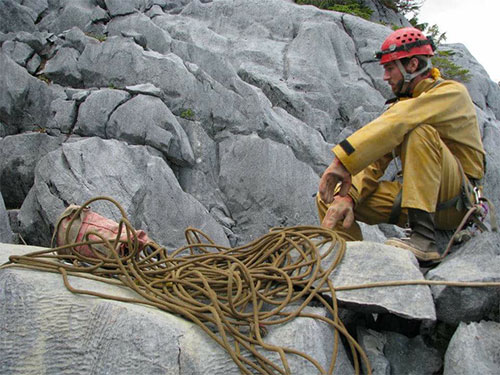
Southeast Alaska caves searched for ice age clues
July 19, 2016
That’s where the University of Alaska Fairbanks doctoral student spent this spring while looking for evidence of a glacial refugium — an area where plants, humans and animals endured amid the icy terrain. Scientists have speculated that such an area existed in Southeast Alaska, partly due to the modern distribution of species like pine trees, marmots, beetles and brown bears. But so far no geologic evidence has emerged to prove it.
Paul Wilcox rests outside a cave during a May research trip to Southeast Alaska.
“They only grow when there’s running water,” Wilcox said of the cave formations. “When it’s frozen, they stop.” Researchers have tried unsuccessfully to find evidence of a glacial refugium by examining sediment cores from lake beds. Wilcox believes this is the first time someone has taken an in-depth look at cave formations to do the same. The Tennessee native became fascinated by Southeast Alaska caves in 2011, when he was part of a survey crew that located them for the U.S. Forest Service. He spent the past two years working out details and lining up funding for the refugium project before leading a team of researchers through about a half-dozen caves in May. The group included Jeff Dorale, a leading Earth and environmental sciences professor from the University of Iowa and a member of Wilcox’s graduate committee. The team collected broken speleothem pieces and a single 22-centimenter core sample from one of the formations. By looking at oxygen and carbon isotopes in speleothem samples, scientists can gauge details such as precipitation and temperature from previous eras, Wilcox said. He hopes to have testing results by the end of the summer and plans to revisit the most promising caves for another round of data collection. The results will also become part of his Ph.D. dissertation at UAF. Even if the research doesn’t find evidence of a glacial refugium, Wilcox believes, the results will be noteworthy. They could also provide more information about conditions during a post-ice age era known as the Younger Dryas, which was a period of rapid climate change. He said that studying such eras could help predict and prepare for future climate change. “There’s going to be something cool about this cave work,” Wilcox said. “We just don’t know what yet.”
Edited by Mary Kauffman, SitNews
Source of News:
Representations of fact and opinions in comments posted below are solely those of the individual posters and do not represent the opinions of Sitnews.
|
||
